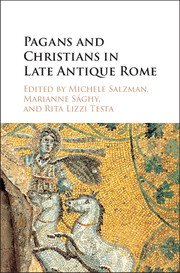 Pagans and Christians in Late Antique Rome
Pagans and Christians in Late Antique Rome Book contents
- Frontmatter
- Contents
- List of Illustrations
- Biographies of Authors
- Acknowledgments
- Introduction
- Part I SENATORIAL POLITICS AND RELIGIOUS CONFLICT
- Part II The Construction of New Religious Identities
- Part III Pagans and Christians: Coexistence and Competition
- Section A Pagans and Religious Practices in Christian Rome
- 8 Reinterpreting the Cult of Mithras
- 9 Napkin Art: Carmina contra paganos and the Difference Satire Made in Fourth-Century Rome
- 10 Poetry and Pagans in Late Antique Rome: The Case of the Senator “Converted from the Christian Religion to Servitude to the Idols”
- 11 Professiones Gentiliciae: The Collegia of Rome between Paganism and Christianity
- Section B Death and the Afterlife
- Section C Reading Religious Iconography as Evidence for Pagan–Christian Relations
- Concluding Remarks: Vrbs Roma between Pagans and Christians
- Index
- References
9 - Napkin Art: Carmina contra paganos and the Difference Satire Made in Fourth-Century Rome
from Section A - Pagans and Religious Practices in Christian Rome
Published online by Cambridge University Press: 05 November 2015
- Frontmatter
- Contents
- List of Illustrations
- Biographies of Authors
- Acknowledgments
- Introduction
- Part I SENATORIAL POLITICS AND RELIGIOUS CONFLICT
- Part II The Construction of New Religious Identities
- Part III Pagans and Christians: Coexistence and Competition
- Section A Pagans and Religious Practices in Christian Rome
- 8 Reinterpreting the Cult of Mithras
- 9 Napkin Art: Carmina contra paganos and the Difference Satire Made in Fourth-Century Rome
- 10 Poetry and Pagans in Late Antique Rome: The Case of the Senator “Converted from the Christian Religion to Servitude to the Idols”
- 11 Professiones Gentiliciae: The Collegia of Rome between Paganism and Christianity
- Section B Death and the Afterlife
- Section C Reading Religious Iconography as Evidence for Pagan–Christian Relations
- Concluding Remarks: Vrbs Roma between Pagans and Christians
- Index
- References
Summary
It has become ever more clear that late ancient Rome's Christian writers were capable of sheer invention. Prudentius’ blood-drenched taurobolium has lately been forced to come clean as the fantasy it was: a burlesque of a far more sober rite still traceable in other sources. Similar, if less sensational, fictions surely underlie the outrage punctuating the roughly contemporary anti-pagan verse polemics considered in this chapter. Yet rather than quarantine these carmina contra paganos – or Prudentius’ lurid fantasy – simply because they bear the mark of deceit, the proper historical task entails their reintegration into a world where, as otherwise agreed, textual practices often had serious motivations and real consequences. The patent attraction of these verses to the tired clichés and vituperative zeal of pre-Constantinian apologetic, that is, should not be permitted to render this poetry irrelevant to the religious debates of the age. Indeed, that these broadsides – embedded in well-known poems or stranded among the manuscripts of other Christian authors – were ever intended to be taken for the kind of truth conceded to objective reportage or fair representation can hardly be the case. Truth, however, is manifold, an assertion whose validity crystalizes in the relentlessly satiric voices of this contra paganos poetry. What follows, then, is a bid for better understanding of how the “banal” fictions of this late fourth- and early fifth-century verse contributed to the work of forging Christian identity in a city where the problems well-heeled Christians faced had as much (or more) to do with resolving the issues dividing them than with fending off the challenges of pagan cult.
Ad Hominem?
Five texts will illustrate here the evidential value of a body of verse too often marginalized as either historically inconsequential or poetically second-rate. Best known of this group, perhaps, is the Contra Symmachum. Prudentius most likely assembled the final version of this two-book rebuttal of Symmachus’ defense of the altar of Victory in late 402, long after Symmachus had sent his famous relatio to Milan in 384. Yet, although Prudentius almost surely drafted parts of Contra Symmachum book one in the mid-390s, attention later in this chapter focuses on lines 42–407, a long section devoted to ridiculing the pagan gods and their myths, which could, in fact, have been composed almost any time during these years.
- Type
- Chapter
- Information
- Pagans and Christians in Late Antique RomeConflict, Competition, and Coexistence in the Fourth Century, pp. 213 - 231Publisher: Cambridge University PressPrint publication year: 2015
References
- 1
- Cited by


